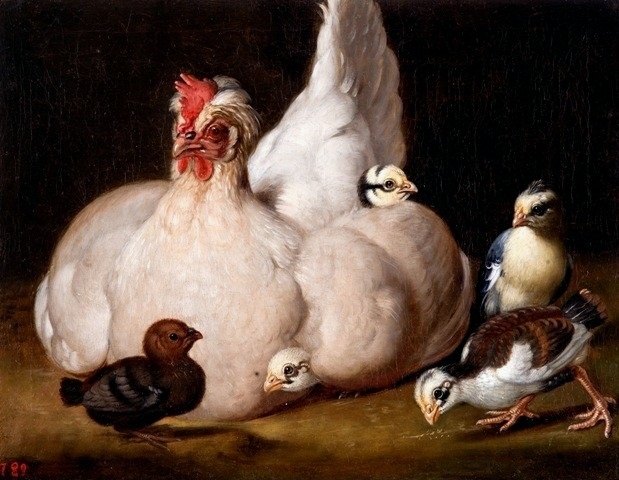Grandchild being in this case a major understatement, but seriously, chickens are amazing. Amazing and amazingly weird.
Take the whole issue of eggs for example. It takes a hen about 26 hours to produce an egg. But when the hen sits on a whole batch of them – up to a dozen – they all hatch around the same time, not at 26 hour intervals for a fortnight. (Assuming a rooster was involved prior to egg-laying. Otherwise no business results and the hen gets bored after a while and wanders off.)
How does she manage to hatch a batch? It’s remarkable. The chicken embryo in the egg doesn’t start developing until it gets nice and warm and a bit humid. So basically the first egg sits around not doing anything for about two weeks while mama piles up a series of other eggs all sitting around not doing anything, until she decides she’s got enough. Then she starts brooding on them, and ta-da! they all start developing at once.
It’s like runners being called to the blocks at one minute intervals, before the starting gun is fired and they all take off together. Brilliant. And also resolving the chicken-or-the-egg dilemma: it was clearly the chicken that came first, or the egg would never have developed and hatched, being un-incubated.
Chickens are remarkable in other ways, too. There is documentary evidence of Brahma chickens which weighed more than eight kilograms. Eight! That’s as much as both of my cats put together, if not more. And Malay chickens can be up to three feet tall. That’s the average height of a child pushing three years old (although mercifully, the Malay chicken isn’t as heavy as said average child).
Chickens don’t have visible ears, but they do have earlobes – in some cases, large and pendulous ones. There is said to be a correlation between earlobe colour and egg colour but, like a French irregular verb, there are so many exceptions you might as well not bother. Sumatra chickens, for example, have dark purple earlobes but lay white eggs, and Araucana chickens have red earlobes (fairly common) but lay blue eggs. Hamburg chickens, on the other hand, have blue earlobes, but lay white eggs.
And speaking of weird colours, according to Christine Heinrichs, if you feed chickens shrimp, they lay eggs with bright pink yolks.
Some chickens have a single comb and some have two side by side, and some have earmuffs and a beard. Made of feathers, obviously. This is chickens we’re talking about. Although crested chickens actually have an extra knob of bone on their head, which they then grow a bunch of extra fluff out of, by way of fancy headgear. Or rather, extra feathers. (Fluff, it turns out, is another term for a chicken’s bum.) Some chickens have hairy legs and some bald; some even have bald necks (yes, it’s as ugly as it sounds).
There is even such a thing as a completely bald chicken, but… well. Let’s just say it makes the Sphynx cat look good and leave it at that. (There’s a picture here, but don’t say I didn’t warn you.)
Those that do have feathers (i.e. almost all chickens) come in a staggering array of colours, shapes etc. Black with yellow wings, white with black dots, white feathers with black edges, stripy, stippled, long-tailed, tail-less, iridescent… There is even a breed noted for its long crow – up to a minute, if you can believe. Where it finds the lung capacity next to all that liver, I can’t imagine.
In fact, there is so much variation between breeds one might be forgiven for thinking them different species. Yet if you park a bunch of wildly different chicken eggs under a broody hen, she will conscientiously hatch them all out and teach them how to chicken, apparently unbothered by their lack of resemblance to each other or even to her.
But then, compared to Ye Olde Ancestor the Tyrannosaurus Rex, one little ball of fluff is much like another. Except of course, that the baby T-Rex might well have been a cute ball of fluff too. A much bigger cute ball of fluff, but one I suspect a big-hearted (if small-brained) broody hen might well attempt to hatch, assuming she could scramble atop the no doubt outsize egg.
Scientific disclaimer: chickens are not actually descended from Tyrannosaurus Rex. They are both theropods from the clade coelurosauria (tells you everything, doesn’t it?), and that’s about as close as the relationship gets. Details here for the sciency-minded or the just plain curious.




